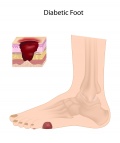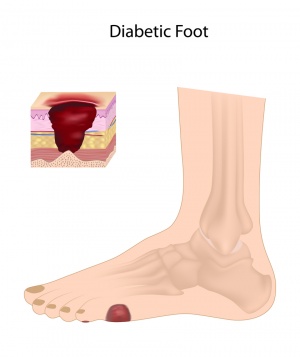Peripheral Neuropathy
Peripheral neuropathy involves a alteration in sensory, autonomic, or motor function of nerves due to nerve damage. Diabetes is most common condition associated with peripheral neuropathy, but it is also associated with toxic exposure, nutritional deficiency, autoimmune disorders and trauma.[1]
|
Peripheral Neuropathy | |
| Causes | Dietary Factors, Smoking, Alcohol, Environmental Toxins, Infections, Prescription Medications |
|---|---|
| See Also | Neurological Conditions, Diabetes, Alcoholism, Atherosclerosis, Hypertension, Hypothyroidism, Carpal Tunnel Syndrome, Autoimmune Disease, Lupus, Rheumatoid Arthritis |
| Books | Books on Neurological Conditions |
| Articles | Articles on Neurological Conditions |
Naturopathic Assessment
Causal Factors
| Article | Peripheral Neuropathy: Pathogenic Mechanisms and Alternative Therapies , Alt Med; 2006;Vol11(4) |
|---|
In order to stimulate the innate ability of the body to heal the causes of disease must be identified and addressed. Peripheral neuropathy may be a symptom of another condition, yet there are factors that directly contribute to its onset.
Lifestyle
- Poor control of diabetes is a major risk factor for development of peripheral neuropathy.[2]
- Vitamin B12 deficiency is linked with peripheral neuropathy.[3] Chronic metformin use, a common medication used in the treatment of diabetes, results in vitamin B12 deficiency.[4]
- Excessive alcohol consumption can cause B vitamin deficiency leading to peripheral neuropathy.[1]
- When poor posture disrupts the blood flow to the legs it can contribute to peripheral neuropathy in the feet.
- Anytime postural imbalances impinge a nerve it can lead to peripheral neuropathy.
External
- Injuries
- An injury, fracture or other trauma that damages or impinges a nerve.
Environmental
- Infections such as Syphilis, Lyme Disease or HIV
- Exposure to heavy metals such as lead and mercury can damage nerves.
- Environmental Chemicals found in cigarettes, glue pesticides and herbicides and solvents may increase the risk and incidence of peripheral neuropathy.[1]
- Climate
- Being exposed to cold temperatures may trigger peripheral neuropathy.
Medical Interventions
- Prescription Medications
- There is a long list of pharmaceuticals known to cause peripheral neuropathy. In particular, many chemotherapeutic agents regularly lead to neuralgia and neuropathy as a primary side effect of treatment.[1]
- Drugs used to treat infections, seizures, and high blood pressure may cause nerve damage.
- Metformin use results in vitamin B12 deficiency in 30% of patients.[4]
- Medical Treatments
- Pressure from bad-fitting casts, splints, a brace, or crutches can damage a nerve.
- Supplements
- High doses of vitamin B6 may contribute to peripheral neuropathy.[1]
Diagnostic Testing
Diagnosis of peripheral neuropathy involves physical exam, clinical history taking, and appropriate laboratory testing.
- Blood tests indicated to assess the cause of neuropathy include: Vitamin B12 Blood Test, TSH, fasting blood glucose, Hemoglobin A1C, glucose tolerance test, antinuclear antibody, ESR, HIV testing, Anti-Hu antibody, Antimyelin-associated glycoprotein.
- Urine tests may include: 24-hr urine for heavy metals or porphyrins
- Other diagnostic studies used to evaluate nerve function include: nerve conduction studies, lumbar puncture, skin biopsy, nerve biopsy, and needle electromyography. Clinical quantitative sensory testing is regularly used as an assessment tool, and involves tool assisted evaluation of nerve sensory function.[5]
Related Symptoms and Conditions
The following disorders are associated with peripheral neuropathy:[5]
- Diabetes
- Alcoholism
- Atherosclerosis
- Hypertension
- Hypothyroidism
- Carpal Tunnel Syndrome
- Chronic kidney disease
- Autoimmune diseases such as Lupus, Rheumatoid Arthritis or Sarcoidosis
- Infections such as Syphilis, Lyme Disease or HIV
- Chronic inflammatory demyelinating polyradiculoneuropathy
- Guillain-Barr syndrome
- Charcot-Marie-Tooth (hereditary)
Symptoms related to peripheral neuropathy include:[5]
- Increased risk of of trauma
- Increased risk of infection
- Neuralgia
Characteristics
Peripheral neuropathy occurs when there is irritation or damage to a peripheral nerve or group of nerves. These nerves are responsible for carrying information to and from the brain and spinal cord to the rest of the body.
- Diabetic neuropathy is one of the most common causes of peripheral neuropathy. Vascular insufficiency due to thickening and occlusion of peripheral blood cells in diabetics leads to nerve damage and neuropathy. It is also postulated that increased concentration of fructose and sorbitol in nerve cells, as well as immunological reaction and vascular abnormalities common in diabetic individuals plays a role in the development of peripheral neuropathy.[1]
Common Symptoms
The symptoms depend on the nerve that is damaged and whether the damage affects one nerve, several nerves or the whole body. Common symptoms in peripheral neuropathy include the following:[5]
- Pain and Numbness
- decreased sensation along the affected nerve
- nerve pain
- tingling (paresthesia) and burning sensation. This typically occurs in the toes and feet.
- reduced tactile sensation or loss of feeling in the legs and arms. If this occurs you may not notice when you step on somthing sharp or when you touch something that is too hot or cold. It is important to monitor the feet closely if this is a concern.
- Muscle Symptoms
- weakness of the affected muscle or joint
- muscle twitches or cramping.
- muscle atrophy or loss of muscle tone
- walking difficulty (in advanced cases)
- Organ Symptoms
- decreased digestive ability. Feeling full or bloated or heartburn after eating very little
- bowels problems, either loose stools or hard stools
- difficulty swallowing
- lightheaded when standing up quickly
- sexual problems
- weakness of the bladder, urinary incontinence
- profuse sweating
Naturopathic Treatment
| Article | The Therapeutic Effects of Acetyl-L-Carnitine on Peripheral Neuropathy: A Review of the Literature, 2010 August Natural Medicine [1] |
|---|
| Article | Successful Treatment of Oxaliplatin- Induced Peripheral Neuropathy with Naturopathy, 2009 July;Vol4(1) IJNM |
|---|
The goal of naturopathic treatment is to support and work in tandem with the healing power of the body and to address the causal factors of disease with individual treatment strategies. Peripheral neuropathy is typically associated with ongoing disease processess or exposures, and the underlying cause must be treated to influence positive outcomes. Naturopathic treatment strategies include decreasing the risk of injury or falls, improving blood flow to the affected area and addressing any underlying contributing conditions or factors.
It is always advisable to work with a naturopathic doctor before engaging in any treatment plan.
Home Care
Home Care strategies include:
- Appropriate footwear is an important factor in the prevention of foot pain in otherwise healthy people or foot ulcers in people with diabetes and peripheral neuropathy. There are specific shoes that are designed for diabetics and those with peripheral neuropathy that have been shown to be beneficial.[6]
- There are also specific diabetic socks that can be helpful in the management of peripheral neuropathy.
- Wearing shoes or slippers all the time is preferred to reduce the risk of injury to the feet.
- Foot Care
- Ensuring proper foot care, including cutting the toe nails and daily inspection of the feet for signs of infection or trauma is recommended.[7]
- Avoid getting the feet damp or cold as this can worsen the problem or cause infection.
- In advanced cases an foot brace may be required.
- Home Safety
To prevent the risk of falls or injuries in the home:[8]
- Ensure that the floors are clear of loose wires, slippery rugs, uneven floor boards or other impediments that increase the risk of falls.
- Add handrails in the bathtub and shower and next to the toilet. Place a slip-proof mat in the bathtub or shower.
- Avoid loose objects lying on the floor.
- Use wheelchairs, braces, or splints as needed to limit nerve damage and to assist with movement.
- Bathing
- Check the temperature of bathwater with your elbow prior to putting your feet in the water to ensure that it is not too hot.
- Avoid any clothing or shoes that are constrictive in the area of the peripheral neuropathy.
- Other
- Avoid putting pressure on areas with nerve damage for too long. For example, if the nerve damage is in an elbow avoid resting your elbow on a desk.
Lifestyle
Lifestyle recommendations include:
- Choose a dietary regimine that controls any underlying condition such as diabetes, atherosclerosis or hypertension.
- Ensure adequate healthy fats.
- Eat foods high in antioxidants such as fruit and vegetables
- Ensure you drink adequate water.
- Daily exercise and moderate activity have been shown to help establish glycemic control, and is therefore may be helpful in preventing and slowing progression of neuropathy. Some studies report that regular exercise in individuals with peripheral neuropathy may increase muscle strength. [9]
- Exercise therapy can improve muscle strength and control.
- Address any postural imbalances to aid in blood and nerve flow and to decrease the risk of falls and injuries.
- Mindfulness meditation may decrease pain quality and increase symptom related quality of life in individuals with diabetic peripheral neuropathy.[10]
Naturopathic Therapies
The prescribing of naturopathic therapies requires the guidance of a naturopathic doctor as it depends on a number of factors including the causal factors, a person's age, prescription medications, other conditions and symptoms and overall health. It is always advisable to work with a naturopathic doctor prior to taking any natural therapies.
Naturopathic Therapies for peripheral neuropathy include:
- Clinical Nutritional Supplementation includes
- Vitamins such as thiamine, pyridoxine, vitamin B12, vitamin E [1]
- Minerals such as magnesium, zinc
- Amino Acids such as Acetyl L-Carnitine,
- Other supplements such as Alpha Lipoic Acid, Capsaicin [1]
- Herbs such as Evening Primrose (Oenothera biennis) oil, Geranium Oil (Geranium spp.)[1]
- Biomechanics
- Transcutaneous electrical nerve stimulation (TENS) has shown benefit in relieving discomfort associated with peripheral neuropathy, and increasing ability to perform physical activity. [13]
References
Reviewed by Iva Lloyd, BScH, RPE, ND [2]
- ↑ 1.0 1.1 1.2 1.3 1.4 1.5 1.6 1.7 1.8 Sunil P. Rakel (2007) Integrative Medicine 2nd ed Chapter 15: Peripheral Neuropathy. Saunders
- ↑ Diabetes Control and Complications Trial Research Group (1995) The effect of intensive treatment of diabetes on the development and progression of neuropathy Ann Intern Med;122:561-568.
- ↑ Steiner I, Kidron D, Soffer D, Wirguin I, Abramsky O (Jan 1988) Sensory peripheral neuropathy of vitamin B12 deficiency: a primary demyelinating disease? J Neurol.;235(3):163-4. PMID: 2835439.
- ↑ 4.0 4.1 Bell DS (Mar 2010) Metformin-induced vitamin B12 deficiency presenting as a peripheral neuropathy. South Med J.;103(3):265-7. PMID: 20134380.
- ↑ 5.0 5.1 5.2 5.3 Rutkove SB (2008) Frontera: Essentials of Physical Medicine and Rehabilitation, 2nd ed Chap 133 Peripheral Neuropathies. Saunders.
- ↑ Actis RL, Ventura LB, Lott DJ, Smith KE, Commean PK, Hastings MK, Mueller MJ (Apr 2008) Multi-plug insole design to reduce peak plantar pressure on the diabetic foot during walking. Med Biol Eng Comput.;46(4):363-71. PMID: 18266017.
- ↑ Shields RW (2010) Cleveland Clinic: Current Clinical Medicine, 2nd ed Sect 10 Neurology Saunders.
- ↑ http://www.ncbi.nlm.nih.gov/pubmedhealth/PMH0001619/
- ↑ White CM, Pritchard J, Turner-Stokes L (2204) Exercise for people with peripheral neuropathy. Cochrane Database Syst Rev(4):CD003904.
- ↑ Teixeira E. (Sept 2010) The effect of mindfulness meditation on painful diabetic peripheral neuropathy in adults older than 50 years. Holist Nurs Pract;24(5):277-83.
- ↑ Abuaisha BB, Costanzi JB, Boulton AJM (1998) Acupuncture for the treatment of chronic painful peripheral neuropathy: A long-term study. Diabetes Res Clin Pract;39:115-121.
- ↑ Abuaisha BB, Costanzi JB, Boulton AJ (Feb 1998) Acupuncture for the treatment of chronic painful peripheral diabetic neuropathy: a long-term study. Diabetes Res Clin Pract.;39(2):115-21. PMID: 9597381.
- ↑ Kumar D, Marshall H (1997) Diabetic peripheral neuropathy: Amelioration of pain with transcutaneous electrostimulation. Diabetes Care;20:1702-1705.

